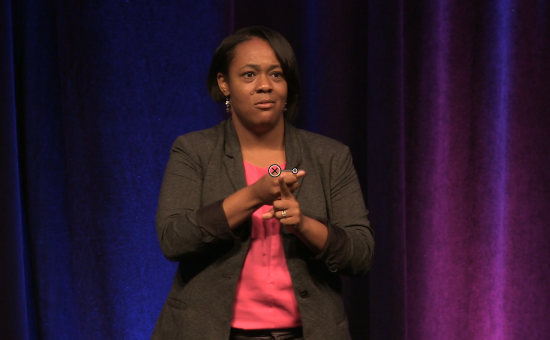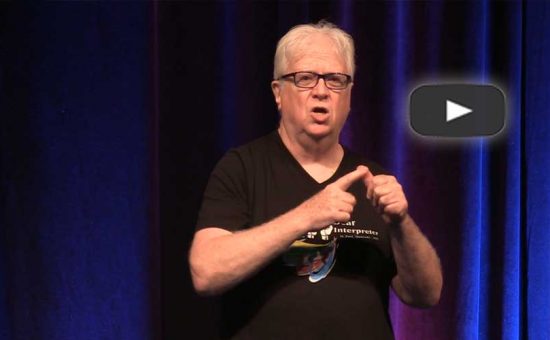Interpret + Person: Presentation of Self and Sign Language Interpreters
Robert Lee presented Interpret + Person: Presentation of Self and Sign Language Interpreters at StreetLeverage – Live 2014 | Austin. His talk explored how the identities of sign language interpreters as individuals cannot be removed from the communicative interactions of their work or the relations they have with the people with whom they work.
You can find the PPT deck for his presentation here.
[Note from StreetLeverage: What follows is an English translation of Robert’s talk from StreetLeverage – Live 2014 | Austin. We would encourage each of you to watch the video and access Robert’s talk directly.]
Interpret + Person: Presentation of Self and Sign Language Interpreters
Hello, everyone. I’m going to start with a story.
I started learning to sign, and I do mean sign – it was not American Sign Language (ASL) – when I was about fifteen or sixteen. My father and I were going to take an adult education class together. When we saw a listing for “sign language” in the course catalogue, we thought it sounded good and signed up. We went to the class, but my father gave up after the first week. I persevered. The instructor for this class was hearing. I remember, on the first night of class, the person told us they would be teaching us to “sign” not that other thing that Deaf people did. Not knowing any better at the time, I continued in the class and learned to “sign”. Later on, I read about ASL. I was intrigued and wanted to learn more. ASL classes weren’t available in the Deaf Education programs at the time, and there were no Deaf Studies programs then. That left the Interpreter Training Program, so I entered the ITP with Eileen Forestal, fortunately for me.
Before entering the Interpreter Training Program though, I could “sign”. When I was working at a department store, I remember a situation that came up. One day, in the appliance department next to mine, a Deaf couple came in, signing with the hearing salesperson who was struggling to communicate. I approached them, signing in an attempt to work with them. They were an older married couple and both seemed very nice. They were trying to purchase a microwave that day. I worked with them as they decided on their purchase and everything worked out pretty well. When they were checking out, the clerk asked if they were interested in having a credit card. They were, so the wife proceeded to fill out the application and signed it. The clerk then indicated that the husband would need to sign the form, as well. When the gentleman signed the form, he merely wrote an “X” on the paper. I was struck by that moment – not in judgment. I was intrigued and perplexed by the situation. Anyway, later on, I went into the Interpreter Training Program and ended up at the Deaf Club. This was my first time there, so I was nervously sitting there when someone tapped me on the shoulder. When I turned, I was surprised to see the man from the department store. He remembered our encounter with enthusiasm and gave me his stamp of approval with a “two-thumbs-up” endorsement. That acceptance was a milestone for me. Where I had previously been a hearing person named #Robert #Lee (first and last name fingerspelled), I became “ROBERT LEE” (Speaker indicates name sign of the combined fingerspelled letters ‘R’ and ‘L’ shaken in neutral space on the right hand). In that moment, I became INTERPRETER, even though I hadn’t completed my training yet. He recognized “who I was” in that moment. It was the beginning of my personal journey.
“I am large. I contain multitudes.” – Walt Whitman
Angela Roth said it’s poetry day today, so in keeping with that theme, a quote from a poem, “I am large, I contain multitudes.” (Speaker indicates waistline when signing “I am large,” laughs and continues.) We each have many identities within us and various identities come to the forefront at different times. We’ll discuss that more later today.
Imagine an Interpreted Interaction
We can all imagine what an interpreted interaction looks like, am I right? In a given situation, we have the interpreter, and minimally, we have a Deaf person and a hearing person. The interpreter is in the middle between the other two participants, so to speak. Let’s talk about “who we are” as the interpreter standing at the center of this interaction and what we represent to the other participants in the interpreted event. Both parties have their own perspective.
Layers of Identity
The multitudes of identity referenced earlier are layers of identity. We are going to focus on three primary layers in this instance. The first layer, and the last one we learn as interpreters, is the professional layer. It is the one we learn in school as we become interpreters. In her plenary presentation, Bilingualism: Are Sign Language Interpreters Bilinguals?, MJ Bienvenu talked about how interpreters use the mantra, “Code of Ethics, Code of Ethics, Code of Ethics,” as they take on a mechanized interpreter persona. She talks about how interpreters wear their professional identity as a shield rather than interacting and collaborating with others. As interpreters, we do have cultural and linguistic identities but they are subjugated by our professional identity. Essentially, we have discarded our human selves in favor of this mechanical “professional” interpreter identity. We keep ourselves separated by merely interpreting the words that are said and do not allow our other identities to surface. That behavior is odd. It’s odd and it is destructive. As interpreters, we stand between two people who do not share a language and therefore, cannot easily interact on their own. By removing our selves and trying to maintain that mechanical “professional” persona exclusively, by not utilizing the cultural and linguistic identities we have to communicate between the Deaf and Hearing parties more naturally, we end up creating more problems.
Interpreter – Interpret (verb) + Person (noun)
Angela Roth mentioned that it’s interesting what we learn by using a language. So, we have the ASL sign that represents “interpreter” – INTERPRET + PERSON. In English, the same concept is represented by the word “interpreter”, a single word utterance. Now, I’ve been pondering this idea. The ASL representation for “interpreter” consists of two parts: INTERPRET – an action, what we do, and PERSON – a noun, who does the action.
If we return to our interpreted interaction with a Deaf and Hearing person and our interpreter in the middle, what are those individuals seeing when they interact with the interpreter? Do they see the same identity? Do they see the identity the interpreter thinks they are portraying? The hearing party likely sees “hearing professional” but the interpreter may not have fully explored who they think they are. Ultimately, we have to question the likelihood that participants in interpreted events see interpreters the way they see themselves.
Identity: Experience vs. Perception
As an individual, I experience my own identity while others perceive it. Sometimes, the experience and the perception are the same, and other times, they are not. A famous British sociologist, Richard Jenkins, studied social identity. He said that we can’t create our identity on our own. Rather, we build identity through our relationships with other people. We cannot create identity for ourselves in isolation. We build our identities through interactions, our experiences and other people’s perceptions.
Tom Humphries and Carol Padden both talked about the physical body of the sign language interpreter. We use our bodies to interpret. American Sign Language, British Sign Language – other signed languages – are visual in nature. If you are using a written language, a person can record a translation in writing and pass that translation along, completely separate from the physical body of the translator. With signed languages, our “self” must always be present, whether we are interpreting on-site in 3D space or on video, interpreting to and from a flat screen, our body, our physical self, is always present. There is no way to remove ourselves from those interactions.
Presentation of Self: I Can Not Interpret Without My “Self”
As an interpreter, the only tool I have is me – my physical body, my facial expressions, my hands, my arms. I can’t become another person. I can use my body to express meaning for both parties in an interpreted event, but my physical self is always present. That’s important to remember. As a profession (and I confess, I’m guilty, as well), I think we have missed the mark in our attempts to ensure that we don’t influence the situations where we interpret. By virtue of taking on that “professional” persona, we are negatively impacting the interaction. This is a problem.
As interpreters, we don’t want to influence situations and we want to ensure that we are conveying meaning between the participants. At the same time, who we are – our selves – part of us, is still present. For example, I’m here presenting right now. Imagine if someone else came to present on this exact topic. Can you picture them? You are probably still seeing me as the presenter. Unfortunately, I’ve influenced you. You see me presenting this topic and it would be a challenge if someone came in and took over in the middle of the presentation. It would be quite jarring if someone came along and we tag-teamed the presentation. That would seem strange and yet, we use this technique all the time in interpreted interactions. We regularly switch interpreters midstream and believe, somehow, the meaning will still be conveyed. We tell ourselves that the Deaf people will adapt. Will they? It’s something to consider. I think we need to start being more aware of our selves as ourselves.
If we go back to the interaction we imagined, we have our interpreter and we have the perceptions the Deaf and hearing consumers have about the interpreter. What do they see? The problem is that they see what we choose to show them, whether on purpose or by accident.
I want to talk a little bit about some research done on racism. Often, we see a person’s actions and we interpret the meaning of their actions. In her talk, Self-Awareness: How Sign Language Interpreters Acknowledge Privilege and Influence, Stacey Storme talked about how we see an “angry Deaf person” and we wonder what they are so angry about. It’s interesting when you look at it. I think this next slide will help us understand our reaction.
Observer vs. Actor Perspective
We have an actor – a person. The person carries all kinds of context with them, consisting of their experiences, background, etc. In any given interaction, we see a tiny portion of that context. We only have access to small parts of an individual’s context. The rest of it is inaccessible to us. If we think about Stacey’s example yesterday with the “angry Deaf person” or MJ’s example that people only see black instead of seeing a whole person – we only see a miniscule part of any given person’s context. As interpreters, our job is to provide that context, to convey it to the participants in interpreted events.
Let’s look at the next slide.
Observer vs. Actor Perspective – Interpreted Interaction
The issue is that we have the interpreter, a person, standing in the middle of a situation with two other people who don’t share a language. The Deaf consumer may see one part of the interpreter’s context while the hearing consumer may see something different. No one can see all of another person’s context. Our job as interpreters is to reveal context, but the problem is that we are always in the middle of the situation. It is difficult to separate how we use language, how we talk about the work and how we discuss our work with others. What kinds of language do we use when working with the Deaf consumer versus the hearing consumer? How can we convey more of the context that is implicit in the communication so that we can make more of each person’s context more explicit? Unfortunately, we haven’t had these conversations much yet. We need some way to provide consumers the opportunity to see through the interpreter’s presence to the reality of the other participants in the situation.
We Are Lenses, but Lenses Can Be Tinted
The context we bring to any situation can be considered a “tint”. For example, I’m a man. I’m white. I’m hearing and I’m an American. I started thinking about this particular topic when I moved to England six years ago. After I moved, I started to meet Deaf people there, started to learn British Sign Language, and started interacting with the language skills that I had. Interestingly, the British Deaf people I’ve met refer to me as “Interpreter.” I don’t interpret in England. I teach interpreting, but I don’t work as a sign language interpreter there – I never have. Still, their perception of me is “interpreter.” That’s how I fit into their community, their schema, their lens. I don’t fit any of their typical categories – my parents are hearing – I’m not a CODA, I’m not Deaf. The category that seems to fit best for that community is “interpreter” – that’s the label I’ve been assigned. I don’t have any issue with that – it’s fine with me. That label is how I fit into their world – it provides context about me. Those people have an idea of what “interpreter” means to them. This is similar to the story I told earlier about the older gentleman at the Deaf Club. Once I had his seal of approval, it served to say to others in the community, “He can be with us.” I was accepted and given a role.
It has been interesting to see that even though I don’t interpret in England, “interpreter” is my assigned role. That’s how the Deaf Community perceives me. Even after numerous attempts to explain that I’m a teacher, the community maintains their perception. I accept the label – I don’t mind being referred to in that way. It’s important to realize that this is a social identity – that identity was created through interactions and relationships I have had. It would be inappropriate for me to declare my own identity as “teacher” when that is not my social identity. My paychecks may say I’m a teacher, but the community’s view is that I’m an interpreter. That’s fine. It’s important for us, regardless of our contexts – interpreter, co-worker, Deaf Community member, etc., to consider the fact that other people’s perceptions and our own may not always match. What we think we are presenting as our identity, our context, may not be what others perceive. How we partner, how we express that is critical. This issue is very important for us. So, what should we be thinking about in terms of how we present ourselves?
Presentation of Self: Identities, Privilege(s) and Language(s)
Some of our identities are obvious. Things like race, gender, general age range, can be seen while others may be less obvious or visible. In England, I can “pass” as a British person until I speak. Once I do, it is easy for people to identify that I am not British. I’m not working towards picking up a fake British accent – at all. Some of my vocabulary has changed since moving to England, but still, when I speak, people can easily and swiftly recognize that I am not British.
I had an interesting experience with this. One night, I went to a pub with a British friend of mine who was hearing. After I ordered a drink, I noticed a man staring at me pretty intently. I acknowledged him and he finally asked if I was Canadian. I corrected him, letting him know that I was an American. He responded to the news by calling out to others that I was American. I was a little taken aback, but asked him about his response. Obviously, my accent is different, but I didn’t know why he had assumed I was Canadian. He explained that he knew I wasn’t British due to my accent, but after observing me in the pub, he realized that I seemed to know the cultural norms of the pub and how to behave appropriately.
To briefly explain, pub behavior in the U.K. is different than in the United States. For example, in the U.S., once patrons have paid for their drinks at the bar, they tend to leave their change there as their tab. In Britain, patrons put their change away after receiving it – they never leave the change on the table the way Americans do. That’s one example of a social rule. Another rule is related to tipping. In England, if a patron likes the service they receive, they may offer the server money to buy a drink for themselves instead of a tip as we know it in the United States.
I’ve learned some of these pub rules and follow them. So, while it was clear that I was a foreigner based on my accent, the man also noted my adherence to pub social rules, so he started ruling out options until he was left with Canadian or American. From there, he made an assumption based on what he had experienced with other Americans. He noted that Americans tend to be loud and exhibit brash behavior and struggle with British currency. When I did not behave that way, he guessed that I was Canadian. I wasn’t sure if I was being complimented, but I thanked him for discussing his perceptions with me.
In this instance, I was obviously an “other” – not “THE other”, but it did take some time for him to determine which “other” I was. My own experience is that I’m an American, but his perception of me was different based on my behavior and his experience. Again, in MJ’s talk, she discussed the way interpreters behave while interpreting versus when they are interacting and how they move between the two. We must recognize that our behavior is how we present ourselves to others.
So, we have our identity and we also have our privilege(s). Stacey talked about privilege in her sessions. My privileges – I’m white, male, I work at a University – I carry multiple privileges. There are other parts of my identity which are not privileged – being gay – sometimes that is not privileged. So, we each carry a balance of privileges and areas where we are not privileged. Ultimately, I choose how I present myself and to whom.
In terms of languages, MJ talked about bi-lingualism and Angela talked about multi-lingualism. I know ASL and English and also I use British Sign Language (BSL) on a daily basis, so that is my third language and a part of how I present myself.
Carol Padden talked about the concept of accent in her talk, Do Sign Language Interpreter Accents Compromise Comprehension? When I sign BSL, most BSL users can immediately note that I am not a native BSL user. They see something about my accent that identifies me as a foreign user of the language. It’s fascinating. So, language is important – how and when we choose to use our language(s) is important. Here at StreetLeverage – Live 2014 in Austin, everyone is using ASL. If we decided not to use ASL here, what would that mean? If I know the language of a country and I refuse to use the language while I’m there, what does that imply? In that instance, that particular identity is not at the forefront. It is, in effect, removed from view. Purposely withholding parts of our identity from other people is a powerful statement. As interpreters, standing in the middle of interpreted interactions, we have to proceed with caution and care. We are in a powerful position.
Recall – INTERPRET (verb) PERSON (noun)
If you remember, we started with the sign for “interpreter” – INTERPRET + PERSON. Again, by using the language, using the ASL sign for “interpreter”, we can come to many understandings about the work, the person behind the work, etc. Maybe we have this concept wrong. Maybe we should consider something else.
Maybe Instead: PERSON (noun) INTERPRET (verb)
We could change the order from INTERPRET+PERSON to PERSON+INTERPRET. We need to explore who we are, our baggage. We need to unpack that baggage, straighten up our clothes a bit and then we can present ourselves to others. Only then can we begin to interpret. Without this self-exploration, everything else is meaningless. The problem MJ talked about – the “interpreter-as-machine” phenomenon – that model is the verb only. It is interpreting without the person. It is important to know the person – who they are. That occurs through negotiations with the Deaf and hearing participants in the interpreted event. Whether the interpreter should present more or less of their personal self can be negotiated. In some situations, it may be appropriate to reveal more of oneself – in settings where the interpreter works on a regular or daily basis, perhaps. Compare that to one-time-only interpreting assignments. At this type of event, it would be inappropriate to be overly effusive with the participants, even if the interpreter knows them well. The negotiation process is critical. It is important to consider how we negotiate and with whom, when we negotiate, etc.
In closing, if we consider the interpreter as a person first, remembering who we are and what we bring, we can then effectively interpret.
Thank you.













